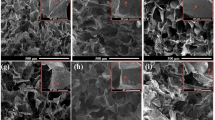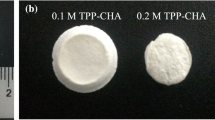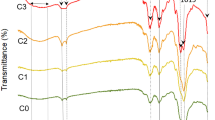Abstract
Biocompatibility and biodegradability characteristics of some polymers make them an excellent candidate to fabricate porous scaffolds for tissue engineering applications. However, the scaffold mechanical properties and biodegradation rate are vital for bone tissue replacement applications, which can be improved using proper fabrication techniques and cross-linker. In this investigation, Chitosan-polyvinyl alcohol scaffolds were prepared by freeze-drying technique utilizing various weight ratios of 3-Glycidoxypropyl trimethoxysilane (GPTMS) as a bioactive inorganic crosslinker. SEM micrographs indicated interconnected porous structures of cross-linked scaffolds while the average diameter of pores increased as a function of cross-linker enhancement. FTIR analysis was performed to confirm interactions among organic and inorganic components. The mechanical strength test represented that increasing GPTMS content improves the compressive strength of samples. The absorption capacity of the scaffolds in the PBS solution exhibited a decrease in water uptake and biodegradation by increasing silane coupling agent concentration. The formation of needle-like apatite particles proved suitable bioactivity of cross-linked samples. Moreover, MTT assay and ALP expression showed an acceptable adhesion, spreading, proliferation, and differentiation of MG-63 cells on the silane-contained scaffolds. Obtained results warrant further preclinical and clinical evaluations.
Similar content being viewed by others
References
Aldemir Dikici B, Dikici S, Karaman O, Oflaz H (2017) The effect of zinc oxide doping on mechanical and biological properties of 3D printed calcium sulfate based scaffolds. Biocybern Biomed Eng 37:733–741. https://doi.org/10.1016/j.bbe.2017.08.007
Bandyopadhyay A, Dewangan VK, Vajanthri KY, Poddar S, Mahto SK (2018) Easy and affordable method for rapid prototyping of tissue models in vitro using three-dimensional bioprinting. Biocybern Biomed Eng 38:158–169. https://doi.org/10.1016/j.bbe.2017.12.001
Mohammadi Y, Soleimani M, Fallahi-Sichani M, Gazme A, Haddadi-Asl V, Arefian E et al (2007) Nanofibrous poly(epsilon-caprolactone)/poly(vinyl alcohol)/chitosan hybrid scaffolds for bone tissue engineering using mesenchymal stem cells. Int J Artif Organs 30:181–277
Kadir MFZ, Aspanut Z, Majid SR, Arof AK (2011) FTIR studies of plasticized poly(vinyl alcohol)–chitosan blend doped with NH4NO3 polymer electrolyte membrane. Spectrochim Acta Part A Mol Biomol Spectrosc 78:1068–1074. https://doi.org/10.1016/j.saa.2010.12.051
Ghorbani F, Zamanian A, Nojehdehian H (2017) Effects of pore orientation on in-vitro properties of retinoic acid-loaded PLGA/gelatin scaffolds for artificial peripheral nerve application. Mater Sci Eng C 77:159–172. https://doi.org/10.1016/j.msec.2017.03.175
Gutiérrez TJ, Alvarez VA (2017) Properties of native and oxidized corn starch/polystyrene blends under conditions of reactive extrusion using zinc octanoate as a catalyst. React Funct Polym 112:33–44. https://doi.org/10.1016/j.reactfunctpolym.2017.01.002
Haque MM-U, Puglia D, Fortunati E, Pracella M (2017) Effect of reactive functionalization on properties and degradability of poly(lactic acid)/poly(vinyl acetate) nanocomposites with cellulose nanocrystals. React Funct Polym 110:1–9. https://doi.org/10.1016/j.reactfunctpolym.2016.11.003
Li N, Liu F, Lu Q, Shi Y, Xiao C, Cheng B (2016) The preparation and study of poly(vinylidene fluoride)/ultrahigh-molecular-weight polyethylene/SiO2 hollow fiber membrane with network enhanced structure. React Funct Polym 109:64–69. https://doi.org/10.1016/j.reactfunctpolym.2016.10.005
Croisier F, Jérôme C (2013) Chitosan-based biomaterials for tissue engineering. Eur Polym J 49:780–792. https://doi.org/10.1016/j.eurpolymj.2012.12.009
Khor E, Lim LY (2003) Implantable applications of chitin and chitosan. Biomaterials 24:2339–2349. https://doi.org/10.1016/S0142-9612(03)00026-7
Gaaz T, Sulong A, Akhtar M, Kadhum A, Mohamad A, Al-Amiery A (2015) Properties and applications of polyvinyl alcohol, halloysite nanotubes and their nanocomposites. Molecules 20:22833–22847. https://doi.org/10.3390/molecules201219884
Witt MA, Barra GMO, Bertolino JR, Pires ATN (2010) Crosslinked chitosan/poly (vinyl alcohol) blends with proton conductivity characteristic. J Braz Chem Soc 21:1692–1698. https://doi.org/10.1590/S0103-50532010000900014
Ghorbani F, Zamanian A, Behnamghader A, Daliri JM (2018) A novel pathway for in situ synthesis of modified gelatin microspheres by silane coupling agents as a bioactive platform. J Appl Polym Sci 46739. https://doi.org/10.1002/app.46739
Tonda-Turo C, Gentile P, Saracino S, Chiono V, Nandagiri VK, Muzio G et al (2011) Comparative analysis of gelatin scaffolds crosslinked by genipin and silane coupling agent. Int J Biol Macromol 49:700–706. https://doi.org/10.1016/j.ijbiomac.2011.07.002
Chen Q, Roether JA, Boccaccini AR (2008) Tissue engineering scaffolds from bioactive glass and composite materials. Top Tissue Eng 4:1–27
He X, Xu H, Li H (2015) Cr(VI) removal from aqueous solution by chitosan/carboxylmethyl cellulose/silica hybrid membrane. World J Eng Technol 03:234–240. https://doi.org/10.4236/wjet.2015.33C034
Fiamingo A, Campana-Filho SP (2016) Structure, morphology and properties of genipin-crosslinked carboxymethylchitosan porous membranes. Carbohydr Polym 143:155–163. https://doi.org/10.1016/j.carbpol.2016.02.016
Jones JR (2015) Reprint of: review of bioactive glass: from Hench to hybrids. Acta Biomater 23:S53–S82. https://doi.org/10.1016/j.actbio.2015.07.019
Marcacci M, Kon E, Moukhachev V, Lavroukov A, Kutepov S, Quarto R, Mastrogiacomo M, Cancedda R (2007) Stem cells associated with macroporous bioceramics for long bone repair: 6- to 7-year outcome of a pilot clinical study. Tissue Eng 13:947–955. https://doi.org/10.1089/ten.2006.0271
Hench LL Third-generation biomedical materials. Science (80- ) 2002(295):1014–1017. https://doi.org/10.1126/science.1067404
Sousa RA (2003) Coupling of HDPE/hydroxyapatite composites by silane-based methodologies. J Mater Sci Mater Med 14:475–487. https://doi.org/10.1023/A:1023471011749
Gomes M, Reis R, Cunha A, Blitterswijk C, de Bruijn J (2001) Cytocompatibility and response of osteoblastic-like cells to starch-based polymers: effect of several additives and processing conditions. Biomaterials 22:1911–1917. https://doi.org/10.1016/S0142-9612(00)00377-X
Ghorbani F, Zamanian A, Behnamghader A, Joupari MD (2018) Microwave-induced rapid formation of biomimetic hydroxyapatite coating on gelatin-siloxane hybrid microspheres in 10X-SBF solution. E-Polymers. https://doi.org/10.1515/epoly-2017-0196
Ren L, Tsuru K, Hayakawa S, Osaka A (2002) Novel approach to fabricate porous gelatin–siloxane hybrids for bone tissue engineering. Biomaterials 23:4765–4773. https://doi.org/10.1016/S0142-9612(02)00226-0
Arabi N, Zamanian A, Rashvand SN, Ghorbani F (2018) The tunable porous structure of gelatin-bioglass nanocomposite scaffolds for bone tissue engineering applications: physicochemical, mechanical, and in-vitro properties. Macromol Mater Eng 303:1700539. https://doi.org/10.1002/mame.201700539
Ghorbani F, Zamanian A (2018) Oxygen-plasma treatment-induced surface engineering of biomimetic polyurethane nanofibrous scaffolds for gelatin-heparin immobilization. E-Polymers 18:275–285. https://doi.org/10.1515/epoly-2017-0185
Kokubo T, Takadama H (2006) How useful is SBF in predicting in vivo bone bioactivity? Biomaterials 27:2907–2915. https://doi.org/10.1016/j.biomaterials.2006.01.017
Aidun A, Zamanian A, Ghorbani F (2019) Novel bioactive porous starch-siloxane matrix for bone regeneration: physicochemical, mechanical, and invitro properties. Biotechnol Appl Biochem 2018:1–29. https://doi.org/10.1002/bab.1694
Lowry OH, Rosebrough NJ, Farr AL, Randall RJ (1951) Protein measurement with the Folin phenol reagent. J Biol Chem 193:265–275
Wang D, Liu W, Feng Q, Dong C, Liu Q, Duan L, Huang J, Zhu W, Li Z, Xiong J, Liang Y, Chen J, Sun R, Bian L, Wang D (2017) Effect of inorganic/organic ratio and chemical coupling on the performance of porous silica/chitosan hybrid scaffolds. Mater Sci Eng C 70:969–975. https://doi.org/10.1016/j.msec.2016.04.010
Asadi-Eydivand M, Solati-Hashjin M, Farzad A, Abu Osman NA (2016) Effect of technical parameters on porous structure and strength of 3D printed calcium sulfate prototypes. Robot Comput Integr Manuf 37:57–67. https://doi.org/10.1016/j.rcim.2015.06.005
Rahman SM, Mahoney C, Sankar J, Marra KG, Bhattarai N (2016) Synthesis and characterization of magnesium gluconate contained poly(lactic-co-glycolic acid)/chitosan microspheres. Mater Sci Eng B 203:59–66. https://doi.org/10.1016/j.mseb.2015.10.011
Hsiao M-H, Tung T-H, Hsiao C-S, Liu D-M (2012) Nano-hybrid carboxymethyl-hexanoyl chitosan modified with (3-aminopropyl)triethoxysilane for camptothecin delivery. Carbohydr Polym 89:632–639. https://doi.org/10.1016/j.carbpol.2012.03.066
Guo R, Hu C, Pan F, Wu H, Jiang Z (2006) PVA–GPTMS/TEOS hybrid pervaporation membrane for dehydration of ethylene glycol aqueous solution. J Memb Sci 281:454–462. https://doi.org/10.1016/j.memsci.2006.04.015
Innocenzi P (2003) Infrared spectroscopy of sol–gel derived silica-based films: a spectra-microstructure overview. J Non-Cryst Solids 316:309–319. https://doi.org/10.1016/S0022-3093(02)01637-X
Shirosaki Y, Okayama T, Tsuru K, Hayakawa S, Osaka A (2013) In vitro bioactivity and MG63 cytocompatibility of chitosan-silicate hybrids. Int J Mater Chem 3:1–7
Enescu D, Hamciuc V, Ardeleanu R, Cristea M, Ioanid A, Harabagiu V et al (2009) Polydimethylsiloxane modified chitosan. Part III: preparation and characterization of hybrid membranes. Carbohydr Polym 76:268–278. https://doi.org/10.1016/j.carbpol.2008.10.026
Connell LS, Romer F, Suárez M, Valliant EM, Zhang Z, Lee PD et al (2014) Chemical characterisation and fabrication of chitosan-silica hybrid scaffolds with 3-glycidoxypropyl trimethoxysilane. J Mater Chem B 2:668–680. https://doi.org/10.1039/c3tb21507e
Chiono V, Tonda-Turo C (2015) Trends in the design of nerve guidance channels in peripheral nerve tissue engineering. Prog Neurobiol 131:87–104. https://doi.org/10.1016/j.pneurobio.2015.06.001
Shirosaki Y, Okayama T, Tsuru K, Hayakawa S, Osaka A (2008) Synthesis and cytocompatibility of porous chitosan-silicate hybrids for tissue engineering scaffold application. Chem Eng J 137:122–128. https://doi.org/10.1016/j.cej.2007.10.012
Ashammakhi N, Ndreu A, Yang Y, Ylikauppila H, Nikkola L (2012) Nanofiber-based scaffolds for tissue engineering. Eur J Plast Surg 35:135–149. https://doi.org/10.1007/s00238-008-0217-3
Gao C, Ito S, Obata A, Mizuno T, Jones JR, Kasuga T (2016) Fabrication and in vitro characterization of electrospun poly (γ-glutamic acid)-silica hybrid scaffolds for bone regeneration. Polymer (Guildf) 91:106–117. https://doi.org/10.1016/j.polymer.2016.03.056
Binsu VV, Nagarale RK, Shahi VK (2005) Phosphonic acid functionalized aminopropyl triethoxysilane-PVA composite material: organic-inorganic hybrid proton-exchange membranes in aqueous media. J Mater Chem 15:4823–4831. https://doi.org/10.1039/b511274e
Duan B, Yuan X, Zhu Y, Zhang Y, Li X, Zhang Y et al (2006) A nanofibrous composite membrane of PLGA-chitosan/PVA prepared by electrospinning. Eur Polym J 42:2013–2022. https://doi.org/10.1016/j.eurpolymj.2006.04.021
Vishal Gupta N, Shivakumar HG (2012) Investigation of swelling behavior and mechanical properties of a pH-sensitive superporous hydrogel composite. Iran J Pharm Res 11:481–493. https://doi.org/10.1021/la980982
Wang J, Fan X, Tian W, Wang Y, Li J (2011) Ring-opening polymerization of γ-glycidoxypropyltrimethoxysilane catalyzed by multi-metal cyanide catalyst. J Polym Res 18:2133–2139. https://doi.org/10.1007/s10965-011-9623-5
Yoon B-H, Kim H-E, Kim H-W (2008) Bioactive microspheres produced from gelatin–siloxane hybrids for bone regeneration. J Mater Sci Mater Med 19:2287–2292. https://doi.org/10.1007/s10856-007-3332-y
Li A, Shen H, Ren H, Wang C, Wu D, Martin RA et al (2015) Bioactive organic/inorganic hybrids with improved mechanical performance. J Mater Chem B 3:1379–1390. https://doi.org/10.1039/C4TB01776E
Liu W, Wu X, Zhan H, Yan F (2012) Synthesis of bioactive poly(ethylene glycol)/SiO2-CaO-P2O5 hybrids for bone regeneration. Mater Sci Eng C 32:707–711. https://doi.org/10.1016/j.msec.2012.01.012
Gao C, Gao Q, Li Y, Rahaman MN, Teramoto A, Abe K (2013) In vitro evaluation of electrospun gelatin-bioactive glass hybrid scaffolds for bone regeneration. J Appl Polym Sci 127:2588–2599. https://doi.org/10.1002/app.37946
Ghorbani F, Zamanian A, Behnamghader A, Joupari MD (2019) A facile method to synthesize mussel-inspired polydopamine nanospheres as an active template for in situ formation of biomimetic hydroxyapatite. Mater Sci Eng C 94:729–739. https://doi.org/10.1016/j.msec.2018.10.010
Shie MY, Ding SJ, Chang HC (2011) The role of silicon in osteoblast-like cell proliferation and apoptosis. Acta Biomater 7:2604–2614. https://doi.org/10.1016/j.actbio.2011.02.023
Author information
Authors and Affiliations
Corresponding authors
Additional information
Publisher’s Note
Springer Nature remains neutral with regard to jurisdictional claims in published maps and institutional affiliations.
Rights and permissions
About this article
Cite this article
Ghorbani, F., Pourhaghgouy, M., Mohammadi-hafshehjani, T. et al. Effect of Silane-Coupling Modification on the Performance of chitosan-poly vinyl Alcohol-Hybrid Scaffolds in Bone Tissue Engineering. Silicon 12, 3015–3026 (2020). https://doi.org/10.1007/s12633-020-00397-2
Received:
Accepted:
Published:
Issue Date:
DOI: https://doi.org/10.1007/s12633-020-00397-2




